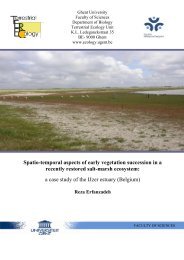PhD Arthur Decae 2010 - Ghent Ecology - Universiteit Gent
PhD Arthur Decae 2010 - Ghent Ecology - Universiteit Gent
PhD Arthur Decae 2010 - Ghent Ecology - Universiteit Gent
You also want an ePaper? Increase the reach of your titles
YUMPU automatically turns print PDFs into web optimized ePapers that Google loves.
The external respiratory organs of mygalomorph spiders are located on the anterior half of the<br />
ventral abdomen as two pairs of book lungs (visible as roughly circular light colored patches).<br />
Most araneomorph spiders have only the anterior pair of book lungs and a more posterior<br />
located tracheal opening that is missing in mygalomorph spiders.<br />
The external spinning organs (spinnerets) of mygalomorph spiders differ from those of other<br />
spiders in the absence of anterior median spinnerets or their homolog, the reduction or<br />
absence of anterior lateral spinnerets and the sub-segmentation of the basal segment of the<br />
posterior lateral spinnerets (Raven 1985).<br />
Table 2. All sixteen currently recognized orthognate spider families with notes on their principal<br />
lifestyles after Jocqué and Dippenaar-Schoeman 2006. Note that in 11 out of 16 families the<br />
production of silk-lined burrows is the dominant lifestyle. Regarding the 6 families that are not<br />
primarily burrowing; three families (Theraphosidae, Dipluridae and Hexathelidae) are known to<br />
contain at least some species that excavate burrows (personal observations) and only three are not<br />
known to excavate burrows at all. These last three families ( Mecicobothriidae, Microstigmatidae and<br />
Paratropididae) are also the families of which very little is known about their habits.<br />
FAMILY LIFESTYLE<br />
1 Actinopodidae Silk-lined burrow with trapdoor<br />
2 Antrodiaetidae Silk-lined burrow with trapdoor or silk collar<br />
3 Atypidae Silk-lined burrow with sock-like extension<br />
4 Barychelidae Silk-lined burrow (retreat) with trapdoor<br />
5 Ctenizidae Silk-lined burrow (retreat) with trapdoor<br />
6 Cyrtaucheniidae Silk-lined burrow with trapdoor<br />
7 Dipluridae Silk-lined retreat in crevices<br />
8 Hexathelidae Silk-lined retreat in crevices<br />
9 Idiopidae Silk-lined burrow with trapdoor<br />
10 Liphistiidae Tubular burrow with trapdoor<br />
11 Mecicobothriidae Silk-line retreat in crevices<br />
12 Microstigmatidae Free-living encrusted with earth<br />
13 Migidae Silk-lined burrow (retreat) with trapdoor<br />
14 Nemesiidae Silk-lined burrow (retreat) with trapdoor<br />
15 Paratropidae Cursorial in leaf litter<br />
16 Theraphosidae Silk-lined burrow, arboreal retreat or cursorial<br />
Fig. 3 Distinguishing Mygalomorphae<br />
from Araneomorphae. A-C ventral views,<br />
B-D frontal views. Differences in<br />
morphology of chelicerae, book lungs and<br />
spinnerets.










